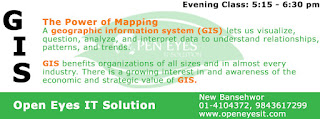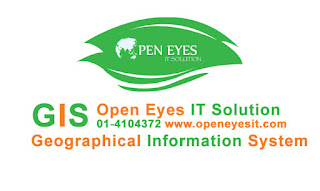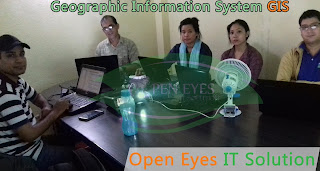 |
| GIS Training in Kathmandu Nepal |
Investigate the power of maps and spatial data to document and illustrate local and global issues. Learn how to use Geographic Information Systems (GIS) to explore the world around you and share ideas. Apply GIS principles and tools to create your own maps from freely-available online spatial data.
Discover the diverse uses of mapping, Geographic Information Systems (GIS) and spatial data, and how they underpin decision-making in every aspect of our lives. Explore and critically appraise maps to gain a better appreciation of the world around you. Learn how to use free open-source software (Quantum GIS) to import, display and analyse spatial data. Collect and integrate spatial data from a variety of sources. Experience realistic tasks in the context of international case studies, which range from resource management, wildlife conservation and leisure hiking to archaeology and disaster relief. Apply your learning to create maps which illustrate your own interests or hobbies, based on sound cartographic principles.
 |
| GIS Training in Kathmandu Nepal |
1. What are spatial data and Geographic Information Systems?
Explore how maps and spatial analysis pervade our world, and consider the use of maps in the media. Install the GIS software and take your first steps in displaying spatial data.
2. Who uses spatial data, maps and GIS, and what for?
Consider how GIS is used in different industries and leisure activities. Encounter the power and versatility of maps and GIS to illustrate patterns, exploring osprey migration routes in a wildlife case study.
 |
| GIS Training in Kathmandu Nepal |
3. Understanding spatial reference systems
Learn how to refer to the spatial location of objects on the earth’s surface, and understand how this translates to locations on a flat map.
4. Representing spatial features
Grasp the difference between discrete spatial objects and continuous surfaces, and learn the characteristics of the two primary data formats (vector and raster) which represent them.
5. Interpreting maps
Interpret the symbols, contours and scale on a topographic map, and learn how to navigate using a compass.
6. Working with raster layers
Experience the power of remotely sensed imagery to visualize environmental patterns.
7. Working with vector layers
Generate and edit your own vector data by hand-digitizing, and add non-geographic information to your new layers. Extend the Pakistan disaster relief case study by calculating the area affected by flooding.
 |
| GIS Training in Kathmandu Nepal |
8. Introduction to symbology and cartography
Explore the art of cartography, and discuss how to communicate your message to a specific audience.
9. Making maps
Learn how the key elements of a map (scale bar, legend, graticule) allow viewers to interpret your map and understand your message.
10. Introduction to spatial analysis
Discover how the utility of GIS extends far beyond map-making. Explore concepts in spatial analysis that will allow you to create new data, identify patterns, and support future decision-making.
No comments:
Post a Comment